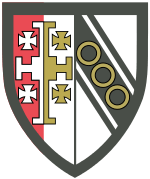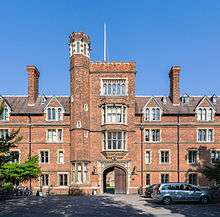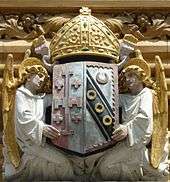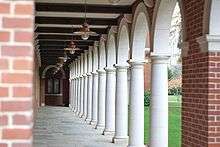Selwyn College, Cambridge
| Colleges of the University of Cambridge | ||||||||||||||||
| Selwyn College | ||||||||||||||||
 | ||||||||||||||||
|
| ||||||||||||||||
| Named after | George Augustus Selwyn | |||||||||||||||
| Established | 13 September 1882 | |||||||||||||||
| Master | Roger Mosey | |||||||||||||||
| Undergraduates | 403 | |||||||||||||||
| Graduates | 180 | |||||||||||||||
| Sister college | Keble College, Oxford | |||||||||||||||
| Location | Grange Road (map) | |||||||||||||||
 | ||||||||||||||||
| ΑΝΔΡΙΖΕΣΘΕ (Ancient Greek, "Quit ye like men!") | ||||||||||||||||
| College website | ||||||||||||||||
| JCR website | ||||||||||||||||
| MCR website | ||||||||||||||||
| Boat Club website | ||||||||||||||||
Coordinates: 52°12′03″N 0°06′20″E / 52.20083°N 0.10556°E Selwyn College is a constituent college in the University of Cambridge in England. The college was founded by the Selwyn Memorial Committee in memory of George Selwyn (1809–1878), who rowed on the Cambridge crew in the first Varsity Boat Race in 1829, and went on to become the first Bishop of New Zealand (1841–1868), and subsequently the Bishop of Lichfield (1868–1878). It consists of three main courts built of brick and stone (Old Court, Cripps Court, and Ann's Court) with some ancillary buildings, including houses serving as student hostels on Grange Road, West Road and Sidgwick Avenue, all on a single site. The college currently has 56 Fellows and around 110 non-academic staff.
In 2006 it had an estimated financial endowment of £22 million, and in 2004 fixed assets were worth £70 million. The college was ranked 16th out of 30 in an assessment of college wealth conducted by the student newspaper Varsity in November 2006.[1]
In 2008, Selwyn was ranked first out of the 29 colleges which admit undergraduate students on the Tompkins Table[2] (3rd in 2009, 4th in 2007, 6th in 2010, 7th in 2006). In 2016 it had fallen to 15th.
Selwyn's sister college at Oxford is Keble College.
History


Following the death of George Augustus Selwyn in April 1878, a former Fellow of St John's College, Cambridge, who had played an important role in the establishment of New Zealand as its first Bishop, the Selwyn Memorial Committee was founded in Spring 1878. It proposed that a new Cambridge college should be established as a memorial to his legacy. The college's first Master, Arthur Lyttelton, was elected on 10 March 1879, the Archbishop of Canterbury (then Archibald Tait) was invited to become Visitor on 28 June 1878, and building of Old Court, as it is now known, began in 1880. The foundation stone of the College was laid by Edward Herbert, 3rd Earl of Powis in a ceremony on 1 June 1881, following a lunch in King's College, Cambridge. A Charter of Incorporation was granted by Queen Victoria on 13 September 1882, and the west range of Old Court was ready for use by the college's official opening (with the Master's installation) on 10 October 1882, in time for Michaelmas term. Selwyn's first 28 undergraduates, joined the original Master and twelve other Fellows at the then Public Hostel of the university in 1882.
It was no longer referred to by the University as "Selwyn College Public Hostel" (or "H. Selw." for short) from June 1924, became an Approved Foundation of the University in 1926, and was granted full collegiate status on 14 March 1958.
The college's founders purchased a six-acre (24,000 m²) farm land site between Grange Road, West Road and Sidgwick Avenue from Corpus Christi College on 3 November 1879 at a cost of £6,111 9s 7d, which is now home to Selwyn's Old Court. The site was originally considered somewhat remote from the centre of the university (indeed, an alternative site on Lensfield Road, where Our Lady and the English Martyrs Church now stands, was considered but rejected as being too small), however, with the growth of departmental buildings, libraries and new faculties, Selwyn (along with Newnham College) now neighbours the Sidgwick Site, affording Selwynites the easiest access of any Cambridge college to the many arts faculty buildings housed there.
The college was founded by subscription, with an explicitly Christian mission. Membership was initially restricted to baptised Christians. The foundation charter specified that the college should "make provision for those who intend to serve as missionaries overseas and... educate the sons of clergymen". The chapel was built in 1895 before the dining hall (in 1909), as it was deemed to be more important, and Chapel attendance was compulsory for students from the College's foundation until 1935. There were originally plans to build a permanent Library between F Staircase and the Chapel to complete Old Court, on land that now forms part of the College Gardens, but this never materialised due to a lack of funds. However, a memorial library was opened in 1928, funded by subscriptions in honour of College members who had died in the First World War.
University education was expensive at the time of Selwyn's foundation, and it was intended to be a college for poorer students, so charges were low. Undergraduates initially paid £27 per term for food, lodgings, lectures and tuition, with a small surcharge for medics, scientists and engineers. This was only raised to £28 in 1916, and £33 in 1918, to keep the College afloat, as admissions drastically decreased due to the First World War.
Selwyn, in common with other Cambridge colleges, originally admitted only men, but was one of the first colleges to become mixed when women were admitted from 1976. In 1976, women lived only on E and H Staircases, but in subsequent years could live anywhere in College. In 2009, Selwyn became the first Cambridge college to appoint a female head porter, Helen Stephens.[3]
Buildings and grounds


Old Court, whose construction began in 1880 and is built in red brick in the Victorian Late Perpendicular Gothic Revival style, was largely designed by Sir Arthur Blomfield and comprises seven staircases (A to G), together with a tower and gateway, Master's Lodge, Chapel, Hall, Kitchens, Music Practice Room, and Archives.
Cripps Court, named after the Cripps Foundation that donated most of the funds to build it (and which also funded developments at St John's College, Queens' College, and Magdalene College) was built and formally opened on 17 May 1969 on land on the opposite side of Grange Road which was originally owned by Jesus College. It comprises a further seven staircases (H to N) and is home to all of Selwyn's first-year undergraduates, a few second-year undergraduates, and most postgraduates and their common room, the Middle Combination Room (MCR).
Ann's Court, built on the land to the north of Old Court and south of West Road, is the newest court: it is named after Ann Dobson, who together with her husband Christopher Dobson (who matriculated at Selwyn in 1957) formed the Ann D Foundation, which is one of the principal donors towards the construction costs of Phases I and II. Phase I was completed in July 2005 and consists of 43 ensuite rooms and 15 administrative offices, forming two staircases (O and P) at a cost of £7.5 million. The second phase, including 40 en-suite bedrooms forming staircases Q and R and a new Junior Combination Room (JCR) at a cost of £2.5 million, was completed in Summer 2009.[4] The College bar was refurbished in 2002, and redecorated in 2011.
The College has planning permission to develop a further three phases of building, planned to be built over the next twenty or more years as funding permits, which will extend the college's red-brick façade along Grange Road to the corner of West Road. The plans consist of a new library and archives (Phase 3) behind Staircase E of Old Court, and two further accommodation blocks (Phase 4) to form a new court (tentatively named Library Court) between Old Court and Ann's Court, and an auditorium (Phase 5) to complete the west side of Ann's Court. The plans for Phase 5 may turn into two more staircases of accommodation, as needs dictate.
Coat of arms and motto

The Selwyn College coat of arms incorporates the arms of the Selwyn family impaled with a version of the arms of the Diocese of Lichfield.
Selwyn College began to use its Arms long before an official grant by the College of Arms (they are displayed above the main gateway, built in 1881, and on the Common Seal, first used in 1882). Arms were finally applied for and granted in the 1960s, and are emblazoned as follows:
- Per pale Gules and Argent a Cross potent quadrate Argent and Or between four crosses paty those to the dexter Argent those to the sinister Or For the See of Lichfield impaling Argent on a Bend cotised Sable three Annulets Or for Selwyn all within a Bordure Sable And for Crest On a Wreath Or & Purpure In front of a Book erect bound Gules edged clasped and garnished Or a representation of the Pastoral Staff of Bishop Selwyn.
The dexter half of the arms (those adapted from those of the See of Lichfield) are unusual, with or (gold) countercharged on argent (silver), violating the rule of tincture, which prohibits a metal to be charged with another metal. This is thought to refer to the arms of the Kingdom of Jerusalem, which also famously violates this rule. Selwyn's pastoral staff (crozier) is based on a hardwood Māori staff which is held in the College Chapel.
The College was also granted a badge, A Mitre Or within an Annulet Purpure.
The College motto is a biblical quotation from 1 Corinthians, chapter 16, verse 13, in Greek, ΑΝΔΡΙΖΕΣΘΕ,[5] translated in the King James Version as "Quit ye like men"[6] (alternatively, in the Douay–Rheims version, "Do manfully"[7] or, in the New American Bible, "Be courageous"[8]). The motto also appears as part of a longer extract, "ΣΤΗΚΕΤΕ ΕΝ ΤΗ ΠΙΣΤΕΙ ΑΝΔΡΙΖΕΣΘΕ", over the main College gate (the full Greek verse of 1 Corinthians 16:13 being "Γρηγορεῖτε, στήκετε ἐν τῇ πίστει, ἀνδρίζεσθε, κραταιοῦσθε·").
Traditions
Formal Hall


Selwyn holds Formal Hall on every Tuesday and Thursday evening during Term at 7:30 pm with a capacity of 120, tickets for which can be bought by all graduate and undergraduate students for themselves and up to two guests, at a cost of £10.50 each for a three-course meal. There used to be an additional Formal Hall held on Sunday evenings at least until the early 1990s.[9] There is also a special, extra Halfway Hall Formal for second-year students to mark the middle of their time as an undergraduate student at the College, and a Christmas Formal for all students at the end of every Michaelmas Term. Selwyn also holds several MCR Dinners for graduate students each term.
College Grace
The College Grace is said by a Scholar (a student who achieved a First Class mark overall in the previous year) at the beginning of Formal Hall, and is as follows:
- Benedic, Domine, nobis et donis Tuis, quae de Tua largitate sumus sumpturi; et concede ut iis muneribus Tuis ad laudem Tuam utamur, gratisque animis fruamur, per Jesum Christum Dominum nostrum. Amen.
Translation:
- Bless us, O Lord, and all your gifts, which of your goodness we are about to enjoy; grant that we may use these generosities to your glory, and enjoy them with thankful hearts, through Jesus Christ our Lord. Amen.
When the High Table rises, the following concluding Grace is said: Benedicamus Domino. (Let us bless the Lord), with the response being: Laus Deo. (Praise be to God.) This response was changed in the 1990s, from the previous response: Deo gratias (Thanks be to God).[9]
Student life
Selwyn has a reputation as one of the friendliest colleges in Cambridge, thanks in part to the many students that come from the neighbouring Sidgwick Site in-between lectures and at mealtimes to take advantage of Selwyn's Servery.
Junior Combination Room Society
Selwyn College Junior Combination Room Society (JCRS) is the students' union for undergraduates students. Elected in Michaelmas term, it organises social and welfare events, negotiates with the College on the students' behalf, and represents Selwyn on Cambridge University Students' Union (CUSU) Council.
It is affiliated to the CUSU and by extension to the National Union of Students. Four Presidents of Selwyn College JCRS have gone on to become CUSU President, one of whom, Wes Streeting, went on to become president of the National Union of Students. Simon Hughes went on to become a Member of Parliament and the Liberal Democrat candidate for Mayor of London.
The Middle Combination Room (MCR) comprises the graduate students of Selwyn College, and is similarly represented by the MCR Committee (MCRc). The presidents and Treasurers of the JCRc and MCRc have sat on College Council, the main decision making body of the College, since it was reformed in 1989.
Societies
The College is host to a number of student societies, such as the Selwyn College Music Society and Selwyn Jazz, and on the stage by Selwyn's amateur dramatics society The Mighty Players. The Chapel Choir is a mixed choirs that has have toured throughout the UK, North America, New Zealand, the Middle East, and much of mainland Europe, and have made over 15 commercial CD recordings under their professional director, Sarah MacDonald.[10] Selwyn College Boat Club is the college rowing club. Selwyn has the longest continually running students' magazine of any Cambridge College – Kiwi has been published from 1982 to present.
Selwyn Snowball
Selwyn is the only Cambridge college to hold an annual Winter Ball known as the Selwyn Snowball, which traditionally takes place on the night of the last Friday of Michaelmas term. In recent years the Snowball has developed into a larger event than it had been in the mid-nineties and now runs three full stages and caters for around 750 guests.
Selwyn May Ball
The May Ball tradition at Selwyn began on 14 June 1948, as hundreds of students dressed in black tie to attend the all-night celebration. May Balls continued to be held at the college throughout the second half of the 20th century with a particular highlight being the performance of The Who in 1967.[11] In recent years, May Balls have been replaced by the Snowball with two notable exceptions: 2008, to celebrate the college's 125th anniversary; and 2015.[12]
Hermes Club
The Hermes Club, founded in 1920, is one of the oldest surviving societies in Cambridge. It exists to encourage and improve sport at Selwyn College – a task it accomplishes by offering financial grants to individual sportsmen/women and college teams, through the lobbying of College, and by generally raising the profile of sport in Selwyn. Members of Selwyn are eligible for invitation to the club if they have been awarded a Full Blue or Half Blue by the University, if they have captained a Selwyn College team in a 'First Class sport', or if they have competed on behalf of Selwyn in two 'First Class' Cuppers competitions.
Alumni of the club fund two major sports grant schemes which award thousands of pounds in grants every year – the Hermes Fund and the Vickerstaff Sports Bursary Scheme.[13]
Notable alumni
| Name | Birth | Death | Career |
|---|---|---|---|
| Clive Anderson | 1952 | Comedian and television show host | |
| Peter Beckingham | 1949 | Governor of the Turks and Caicos Islands | |
| Richard Budgett | 1959 | 1984 Olympic rowing gold medallist | |
| Ralph Chubb | 1892 | 1960 | Poet and printer |
| Deryck Cooke | 1919 | 1976 | Musicologist and broadcaster |
| A. R. Cornelius | 1903 | 1991 | Former Chief Justice of the Supreme Court of Pakistan |
| Huw Davies | 1959 | England Rugby Fly Half 1981-6[14] | |
| John Selwyn Gummer | 1939 | British politician | |
| Peter Selwyn Gummer | 1942 | Businessman | |
| Richard Harries | 1936 | Former Bishop of Oxford and Life Peer | |
| Robert Harris | 1957 | Author | |
| Tom Hollander | 1967 | Actor | |
| Karl Hudson-Phillips | 1933 | Judge | |
| Angus Maddison | 1926 | 2010 | Economist |
| Simon Hughes | 1951 | Politician | |
| Grayston "Bill" Ives | 1948 | Composer | |
| Lionel Charles Knights | 1906 | 1997 | Literary critic |
| Robert Lacey | 1944 | British historian and biographer | |
| Hugh Laurie | 1959 | Comedian and actor, son of Ran Laurie | |
| Ran Laurie | 1915 | 1998 | 1948 Olympic rowing gold medallist |
| Andrew Lawrence-King | 1959 | Musician | |
| Sir David Li | 1939 | Chairman and Chief Executive of the Bank of East Asia | |
| Ivan Lloyd-Phillips | 1910 | 1984 | Civil servant |
| Sir Richard May | 1938 | 2004 | Judge |
| David Miller | 1946 | Political theorist | |
| Barry Morgan | 1947 | Archbishop of Wales | |
| Malcolm Muggeridge | 1903 | 1990 | Author and journalist |
| Robert Newman | 1964 | Comedian | |
| Nigel Newton | 1955 | Founder of Bloomsbury Publishing | |
| Sir Edwin Nixon | 1925 | 2008 | Managing director of IBM (UK) |
| Julian Pearce | Bigsby Medal and Murchison Medal winning geochemist | ||
| John Saunders | 1953 | Full international level chess player & Chess Magazine editor | |
| John Sentamu | 1949 | Archbishop of York | |
| Sir Peter Singer | 1944 | Judge | |
| Adrian Smith | 1957 | Statistician | |
| Sir Peter Smith | 1952 | Judge | |
| Tim Stevens | 1946 | Bishop of Leicester | |
| Graham Stuart | 1962 | British politician | |
| Nick Tanner | 1978 | Actor | |
| David K.R. Thomson | 1957 | Member of Canada's wealthiest family | |
| D. R. Thorpe | 1943 | Political biographer | |
| Sir Stephen Wall | 1947 | Diplomat | |
| General Sir Peter Wall | 1955 | Professional head of British army |
See also
- Fellows of Selwyn College, Cambridge
- Masters of Selwyn College, Cambridge
- Selwyn College Boat Club — the college rowing club
- List of organ scholars
References
- ↑ Varsity issue 647, page 6. (PDF) . Retrieved on 22 December 2013.
- ↑ Garner, Richard (28 July 2008). "'Poorer' college tops Cambridge degree table". The Independent. Retrieved 31 July 2008.
- ↑ "Cambridge College first as Helen is appointed". "This is South Wales". 9 September 2009.
- ↑ Kilpatrick, Heather (June 2009). Selwyn College Cambridge – Ann's Court: The story so far. Selwyn College Cambridge.
- ↑ 1 Corinthians 16. Users.cs.york.ac.uk. Retrieved on 22 December 2013.
- ↑ Bible, King James Version. Hti.umich.edu. Retrieved on 22 December 2013.
- ↑ 1 Corinthians – Challoner Douay Rheims version of the Sacred Bible. Sacredbible.org. Retrieved on 22 December 2013.
- ↑ The New American Bible – IntraText. Vatican.va. Retrieved on 22 December 2013.
- 1 2 http://www.societies.cam.ac.uk/cuhags/talks/graces/
- ↑ Selwyn College » Selwyn Merchandise. Sel.cam.ac.uk (24 February 2013). Retrieved on 17 August 2013.
- ↑ Cambridge University ball season | Cambridge News. cambridge-news.co.uk/. Retrieved on 8 December 2014.
- ↑ Selwyn May Ball. selwynball.com. Retrieved on 8 December 2014.
- ↑ , Sports Bursary Scheme.
- ↑ .
External links
| Wikimedia Commons has media related to Selwyn College, Cambridge. |
- Selwyn College Official website
- Selwyn College JCR Committee Official website
- Selwyn College MCR Official website
- Selwyn May Ball website
- Selwyn Snowball website
- A new court for Selwyn (University of Cambridge press release, 22 September 2005)
- Official Selwyn College Boat Club website
